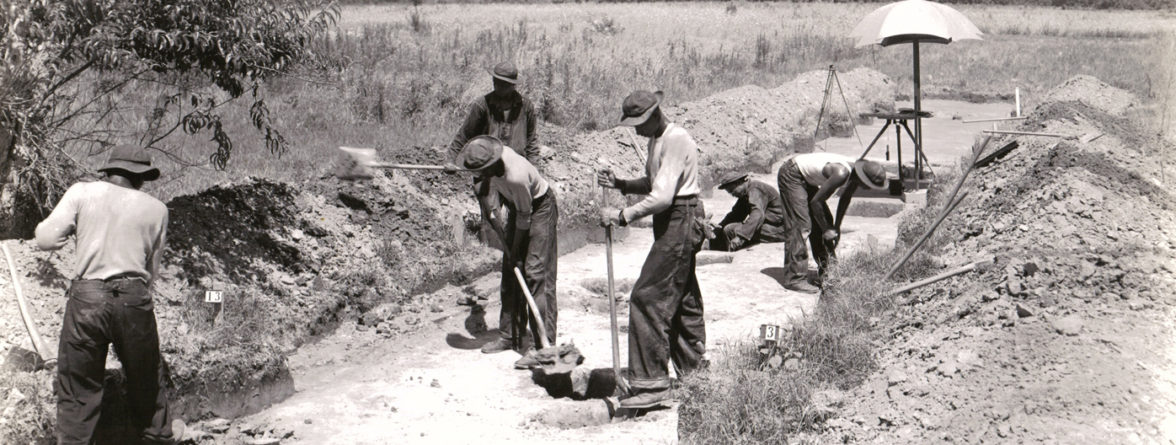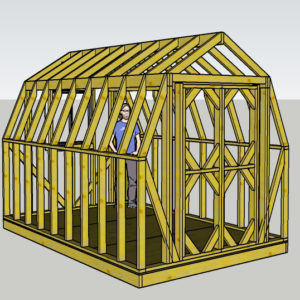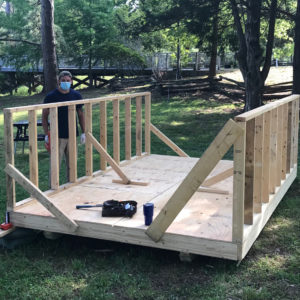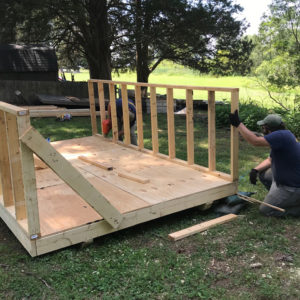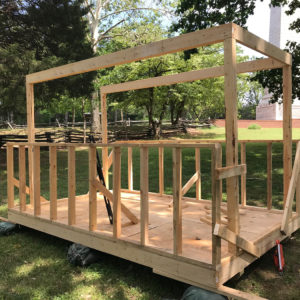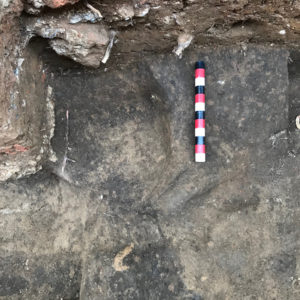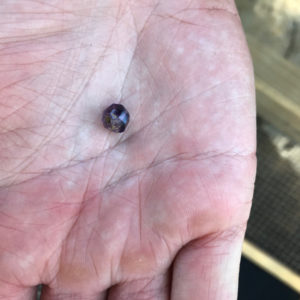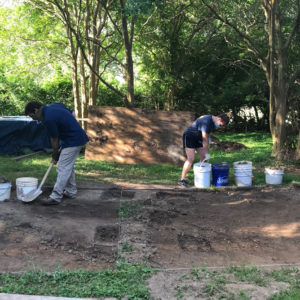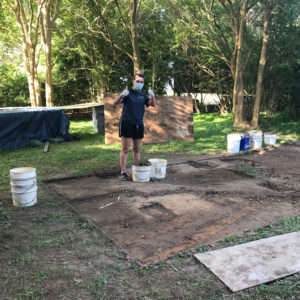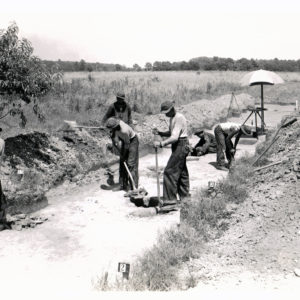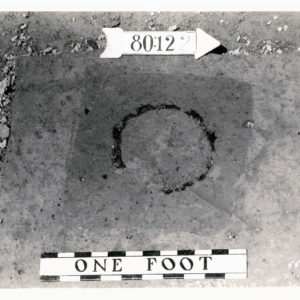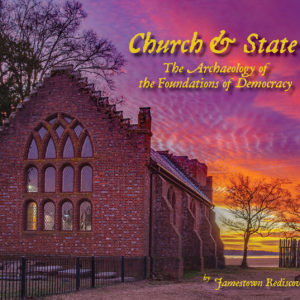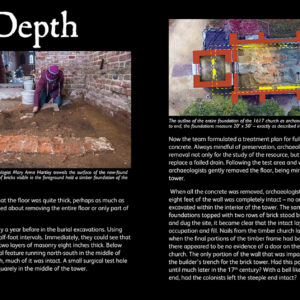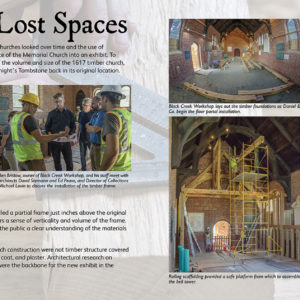The Jamestown Rediscovery team recently returned to Jamestown Island, after spending the last several weeks working remotely. While we have not been able to excavate on the Island, the team has been diligently working on researching and writing for past and upcoming projects—something we often struggle to find time to do! Now back on site, the team has gone right back to work on both old and new projects.
One of the tasks we had wanted to do in the spring was to replace our old storage shed. The team stores excavation equipment—our shovels, trowels, rulers, and other items—in the old shed, which has been a fixture at Jamestown since the early years of our excavations. After nearly 20 years of service, the old shed is finally in need of replacement.
Last year, the Jamestown Rediscovery team built custom structures around our burial excavations, to protect the human remains in those burials from environmental damage and potential contamination with modern DNA. That experience taught the team a lot about designing and maintaining a structure. When it came time to replace our old shed, the team decided to custom-build a new one, using the lessons learned from last year’s environmental control structures. Designed by Director of Archaeology David Givens, the new shed will be slightly larger than our old one, and takes some of its design cues from the 17th- and 18th-century historic buildings we have researched in the past. Right now, the new building is just over halfway done. Keeping in line with our “green” efforts, nearly all of the lumber used was up-cycled from the burial structures.
The Archaeology crew has also been excavating in two areas: south of the Memorial Church, and behind our museum, the Archaearium. The excavations by the Memorial Church were begun last year, and exposed a lot of features, including the brick pad that marked the original entryway into the 1639 Brick Church. At the end of last year, we uncovered the remains of planting furrows in the same area. These furrows are the remnants of early farming activities by the English colonists, and are situated just west of the original triangular fort. The furrows survive in a few places—we even found one inside the Memorial Church—but have been cut through by burials and other features, including the 1617 Church foundations. Right now, the team is mapping the locations of these furrows, so we can see if they match with others we have previously found.
The excavations behind the Nathalie P. & Alan M. Voorhees Archaearium are new this year. The Collections team needs a shed installed for additional storage space. The spot they selected for the shed was behind the Archaearium, and the Archaeology team began excavations there to ensure no archaeological features would be impacted by any new construction. The team also conducted a ground-penetrating radar (GPR) survey across the space, to get a look at what we might uncover. The GPR survey indicated that a large feature was present next to where the shed will be built. This feature appears to be a large ditch, possibly part of an early fortification for Jamestown Island. We have just begun excavations behind the Archaearium but will hopefully be uncovering this intriguing feature soon.
This year for Juneteenth, the archaeology team would like to recognize the contributions and achievements of some our predecessors at Jamestown. In the 1930s, at the height of the Great Depression, archaeologists, many of whom were segregated African Americans, toiled in the hot sun to understand the context of early Jamestown. Often an under recognized facet of the history of the Island, the Civilian Conservation Corps (CCC) archaeology was a “shovel ready” component of President Franklin Delano Roosevelt’s New Deal that promised work for all Americans regardless of race.
In the Depression, the majority of Jamestown Island had recently been purchased by the Department of the Interior (DOI) and was a favored place of FDR. In 1934 the DOI began excavations on the Island mostly in “New Towne,” the core of the 17th-century town and capitol. For years they peeled back the layers of soil, elegantly pairing their findings with the sparse colonial records. From the hard work of the DOI and CCC team emerged a comprehensive plan of the town that is the starting point for many researchers of the Island’s history and archaeology. The coordinate system the Jamestown Rediscovery archaeology team uses today to locate features and excavation areas was established in 1934!
As archaeologists, we inherit the legacy of those who excavated before us—both the good and the bad—and it is our responsibility to understand and study that past and remember it. The CCC and DOI team laid the foundation for modern archaeological research at Jamestown. We exist only because they forged a way before us—often in contexts far more challenging than that faced by us today.
Jamestown Rediscovery is proud to announce the arrival of their new book Church & State, a summary of the excavations in the Memorial Church and Tower. The book recounts the three years of excavations conducted in search of the 1617 Church, where Virginia’s first General Assembly meeting was held in 1619, and the uncovering of several skeletons within the church, including one mysterious high-status individual. Along with our previous publications Jane and Holy Ground, Church & State provides the reader with an inside perspective on the forensic pursuits of the archaeologists as they apply history, science, and archaeology to understand one of our Nation’s most poignant locations. Church & State is available for sale here.
Although Jamestown Island is still closed to the public, it will be reopening soon. Please check our website for information about our reopening plans, and we look forward to seeing you at Jamestown soon.
related images
- The design for our new storage shed
- Archaeologist Ryan Krank hard at work building the new shed
- Getting the walls secured
- Our progress on the shed so far
- Features uncovered south of the Memorial Church. Some of these are likely planting furrows.
- A bead uncovered while excavating south of the Memorial Church
- Archaeologists excavating behind the Archaearium
- Archaeologist Nicole Roenicke is excited to be back in the field
- Civilian Conservation Corps (CCC) clearing brush on the Elay-Swann tract located on the eastern side of Newtowne, Jamestown Island, in 1937. Image courtesy of the Carl F. Miller papers and the Archeological Society of Virginia
- CCC workers excavating on the Elay-Swann tract, located on the eastern site of Newtowne, Jamestown Island, in 1937. Image courtesy of the Carl F. Miller papers and the Archeological Society of Virginia
- An excellent example of a post-in-ground feature with intact wood. Although not often the case, archaeologists occasionally find intact wood in centuries-old features. Image courtesy of the Carl F. Miller papers and the Archeological Society of Virginia
- Our new book, “Church & State,” has just been released! Check out the sample pages here in the photo gallery
- Sample pages from “Church & State” discussing our contamination-prevention measures while excavating burials inside the Memorial Church
- Sample pages from “Church & State” discussing the excavations within the 17th-century church tower
- Sample pages from “Church & State” discussing the creation of the 1617 Church exhibit inside the Memorial Church


